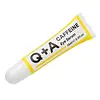What's inside
What's inside
 Key Ingredients
Key Ingredients

 Benefits
Benefits

 Concerns
Concerns

 Ingredients Side-by-side
Ingredients Side-by-side

Water
Skin ConditioningAloe Barbadensis Leaf Juice
Skin ConditioningGlycerin
HumectantHamamelis Virginiana Water
AstringentTripeptide-29
Skin ConditioningFucus Vesiculosus Extract
EmollientChondrus Crispus Extract
Skin ConditioningLimonium Vulgare Flower/Leaf/Stem Extract
Skin ConditioningLaminaria Digitata Extract
Skin ProtectingThymus Serpyllum Extract
Skin ConditioningSodium Gluconate
Skin ConditioningCarbomer
Emulsion StabilisingLeuconostoc/Radish Root Ferment Filtrate
AntimicrobialPotassium Sorbate
PreservativePhenoxyethanol
PreservativeCaprylyl Glycol
EmollientSodium Benzoate
MaskingSodium Hydroxide
BufferingAlcohol
AntimicrobialCitric Acid
BufferingWater, Aloe Barbadensis Leaf Juice, Glycerin, Hamamelis Virginiana Water, Tripeptide-29, Fucus Vesiculosus Extract, Chondrus Crispus Extract, Limonium Vulgare Flower/Leaf/Stem Extract, Laminaria Digitata Extract, Thymus Serpyllum Extract, Sodium Gluconate, Carbomer, Leuconostoc/Radish Root Ferment Filtrate, Potassium Sorbate, Phenoxyethanol, Caprylyl Glycol, Sodium Benzoate, Sodium Hydroxide, Alcohol, Citric Acid
Water
Skin ConditioningPropylene Glycol
HumectantBetaine
HumectantPentylene Glycol
Skin ConditioningCaffeine
Skin ConditioningCucumis Sativus Fruit Water
Skin ConditioningCollagen
MoisturisingBiosaccharide Gum-1
HumectantCamellia Sinensis Leaf Extract
AntimicrobialPunica Granatum Extract
AstringentLonicera Caprifolium Flower Extract
PerfumingLonicera Japonica Flower Extract
Skin ConditioningLactobacillus Ferment Filtrate
Skin ConditioningLeuconostoc/Radish Root Ferment Filtrate
AntimicrobialSodium Phytate
Glycerin
HumectantLactobacillus Ferment
Skin ConditioningXanthan Gum
EmulsifyingAlcohol
AntimicrobialSodium Levulinate
Skin ConditioningGlyceryl Caprylate
EmollientSodium Anisate
AntimicrobialLactic Acid
BufferingWater, Propylene Glycol, Betaine, Pentylene Glycol, Caffeine, Cucumis Sativus Fruit Water, Collagen, Biosaccharide Gum-1, Camellia Sinensis Leaf Extract, Punica Granatum Extract, Lonicera Caprifolium Flower Extract, Lonicera Japonica Flower Extract, Lactobacillus Ferment Filtrate, Leuconostoc/Radish Root Ferment Filtrate, Sodium Phytate, Glycerin, Lactobacillus Ferment, Xanthan Gum, Alcohol, Sodium Levulinate, Glyceryl Caprylate, Sodium Anisate, Lactic Acid
 Reviews
Reviews

Ingredients Explained
These ingredients are found in both products.
Ingredients higher up in an ingredient list are typically present in a larger amount.
Alcohol comes in many different forms. Different types of alcohol will have different effects on skin. This ingredient is usually an astringent alcohol.
These alcohols are drying on the skin. They may strip away your skin's natural oils and even damage your skin barrier. Astringent alcohols may also irritate skin.
Other types of astringent alcohols include:
According to the National Rosacea Society based in the US, you should be mindful of products with these alcohols in the top half of ingredients.
Any type of sanitizing product will have high amounts of alcohol to help kill bacteria and viruses.
Fatty alcohols come from plant oils such as coconut oil. These can help hydrate the skin and are non-irritating. Some fatty alcohols include cetyl and stearyl alcohol.
Learn more about AlcoholGlycerin is already naturally found in your skin. It helps moisturize and protect your skin.
A study from 2016 found glycerin to be more effective as a humectant than AHAs and hyaluronic acid.
As a humectant, it helps the skin stay hydrated by pulling moisture to your skin. The low molecular weight of glycerin allows it to pull moisture into the deeper layers of your skin.
Hydrated skin improves your skin barrier; Your skin barrier helps protect against irritants and bacteria.
Glycerin has also been found to have antimicrobial and antiviral properties. Due to these properties, glycerin is often used in wound and burn treatments.
In cosmetics, glycerin is usually derived from plants such as soybean or palm. However, it can also be sourced from animals, such as tallow or animal fat.
This ingredient is organic, colorless, odorless, and non-toxic.
Glycerin is the name for this ingredient in American English. British English uses Glycerol/Glycerine.
Learn more about GlycerinLeuconostoc/Radish Root Ferment Filtrate is a natural preservative. It comes from fermenting radish roots with a bacteria called leuconostoc.
Leuconostoc comes from lactic acid.
This ingredient has antimicrobial properties and helps prevent the growth of bacteria in a product.
Leuconostoc is used to make the traditional Korean side-dish, kimchi. It is also used to make sourdough bread (both incredibly yummy foods).
Learn more about Leuconostoc/Radish Root Ferment FiltrateWater. It's the most common cosmetic ingredient of all. You'll usually see it at the top of ingredient lists, meaning that it makes up the largest part of the product.
So why is it so popular? Water most often acts as a solvent - this means that it helps dissolve other ingredients into the formulation.
You'll also recognize water as that liquid we all need to stay alive. If you see this, drink a glass of water. Stay hydrated!
Learn more about Water